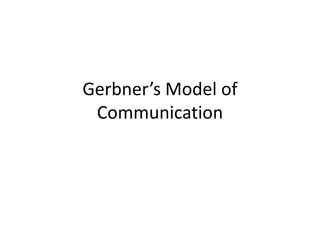
Gerbner’s model of communication
- 1. Gerbner’s Model of Communication
- 2. • Mr. George Gerbner is one of the pioneers in the field of communication research. • His works are descriptive as well as very easy to understand any other before. • He is working as a professor and head of the Annenberg School of Communications in the University of Pennsylvania. • In 1956, Gerbner attempted the general purpose of communication models. • He stressed the dynamic nature of communication in his work and also the factor which affecting the reliability of communication.
- 3. (Note: This model can be best understood when read along with the diagram beginning at E – Event.)
- 4. • (i) Perceptual Dimension: • An ‘E’ is an event happens in the real life and the event content or message is perceived by ‘M’ (Man or a Machine). After Perceives the message from “E” by “M” is known as “E1”. E1 is not same as like ‘E’. Because any man or machine can’t perceives the whole event and they perceives only the part of the event (E1). This is known as “Perceptual Dimension”.
- 5. • These 3 factors are involves between ‘E’ and ‘M’ • Selection • Context • Availability
- 6. • M (man or machine) cannot perceive the entire content of the event “E”. • So M selects the interesting or needed content from the entire event and filtering the others. • The context occurs in the event and Availability is based on ‘M’s attitude, mood, culture and personality. • (For eg. How a journalist perceives the messages from the event and also can’t focus the whole event so they filter the unwanted or unrelated content from the event. This filtered content is not same as like the actual event content because the journalist edits the content based on his attitude, mood and cultural background or press policies).
- 7. • (ii) Means and Controls dimension: • E2 is the event content which is drawn or artified by M. Here M becomes the source of a message about E to send someone else. M creates a statement or signals about the message and Gerbner termed its Form and content as “SE2”. S (Signal or Form) it takes and E2 (Man’s content). Here Content (E2) is structured or formed (S) by ‘M’ and it can communicate in a different ways or based on the structured ways.
- 8. • M has to use channels (or media) over to send the message which he has a greater or lesser degree of control. The question of ‘control’ relates to M’s degree of skill in using communication channels. If using a verbal channel, how good is he using words? If using the Internet, how good is he at using new technology and words?
- 9. • This process can be extended to infinitum by adding on other receivers (M2, M3etc.) who have further perceptions (SE3, SE4 etc.) of the statements about perceived events. • Important Note: • Message at every level is altered or changed.
- 10. • Example: • In case of news reporting, E can be any event that has happened and the reporter (M) selects a particular part of event (E1) that may be provide his channel higher TRP ratings or the news may boost the particular party which his channel supports. This SE2 is sent through a medium to the mass audience. Then the audience distributed the message (SE2) and he (M1) sends to his friends with his interpretation and the process continues.
- 11. Gerbner’s General Model (1956) PERCEPTUAL DIMENSION Selection Context Availability E Event M E1 Channels Media Control MEANS AND CONTROL DIMENSION S Form E Con-tent M2 SE1 (cf. Gerbner 1956, in: Corner; Hawthorn (eds.) 1989:18)
- 12. References • http://en.wikipedia.org/wiki/George_Gerbner • http://communicationtheory.org/gerbners-general- model/
